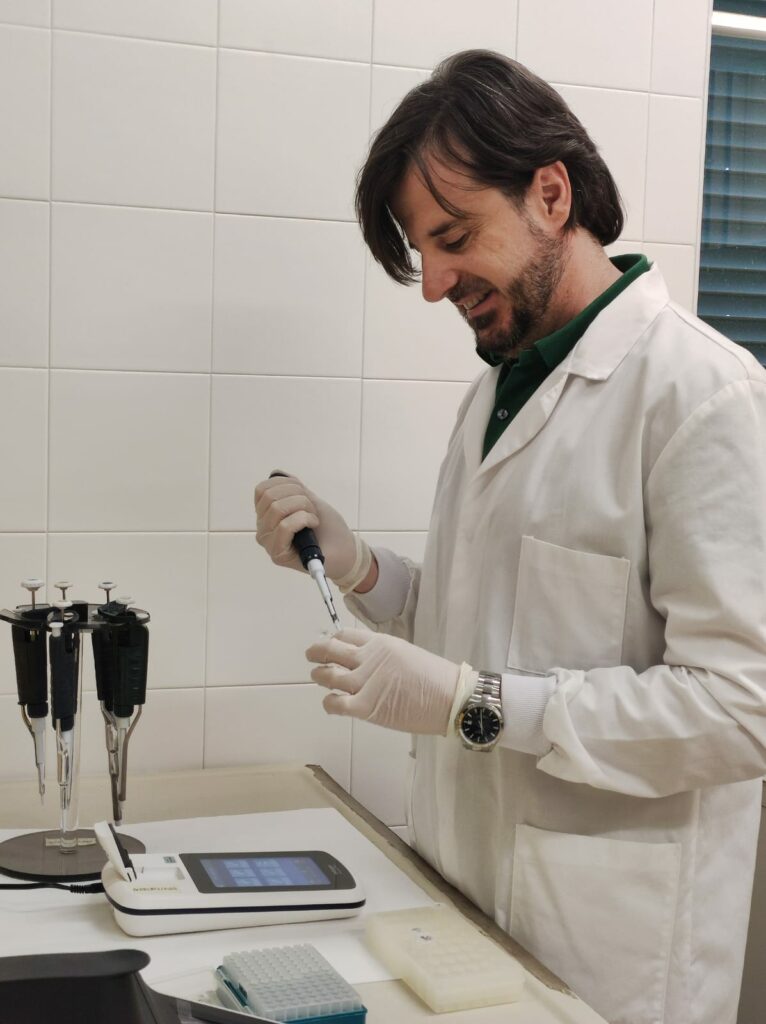Using ISIS@MACH ITALIA X-Ray Diffraction and FT-IR instruments, Dr. Scorrano from Unit Rome Tor Vergata is analysing rock fragments that may contain some of the oldest DNA ever discovered.
by Shibl Gill – 6 June 2024
Studying the ancient history of humankind is tough business. Most archaeologists and anthropologists excavate and analyse artifacts left behind by populations thousands and hundreds of thousands of years ago. Dr. Scorrano is a different kind of anthropologist: a geneticist studying fragments of ancient DNA that are millions of years old.

Dr. Scorrano in his lab
Focusing on archaeological projects in Italy, Northern France, Denmark and Sweden, Dr. Scorrano is on the lookout for bone fragments, sediment samples that can preserve genetic information, and geological samples that may contain biological material. What’s challenging is identifying which rock samples may be hiding viable genetic information deep within them.
So when Dr. Scorrano came across a millions of years old rock sample that contained a trapped water bubble, he was immediately intrigued by the possibility of discovering some of the most ancient DNA ever studied. The question was, is there ancient DNA trapped inside that primordial water bubble?
Dr. Scorrano explains that there are certain kinds of sediments that, through a chemical-physical process, can bind to DNA. Through particular adsorption mechanisms on the surface, DNA can be protected from enzymatic degradation and preserve the genetic material for a long period of time. Building on previous work done by Kjaere et al (Nature 612: 283–291) from the University of Copenhagen where they analysed ice cores from Greenland, determining what kinds of sediments can bind to DNA, it is expected that these findings will help in identifying promising samples.
Often, samples collected from the field need to be analysed using a spectrum of techniques before DNA extraction and sequencing can be carried out. Dr. Scorrano determined that he needed to perform X-Ray diffraction studies on his sample to determine its sediment makeup and evaluate the sample’s adsorption capacities. Next, to detect any organic matter in the water bubble trapped inside the rock, Dr. Scorrano proposed using Fourier Transform Infrared Spectroscopy. He only uses milligram amounts of sample in these analyses, preserving the majority of the sample for future works.
This is where a chance conversation with Tor Vergata Prof. Carla Andreani alerted Dr. Scorrano to the ISIS@MACH ITALIA composite material analysis infrastructure. Offering access to over forty instruments for materials analysis, including X-Ray diffractometers and FT-IR instruments, submitting proposals to IM@IT was an easy choice for Dr. Scorrano. Commenting on the process he said “It is a huge network, and it was so quick, easy, and cheap! Having access not only to the instrument, but the instrument scientist is a big plus for me. We can discuss the best sample, the best approach to organise the experiment.” It is crucial for him and his collaborators to have access to the IM@IT pool of expertise to get the best results out of the instruments.
The multidisciplinary nature of the IM@IT infrastructure was also highlighted by the experiment proposed by Dr. Scorrano. At the intersection of genetics, archaeology and physics, Dr. Scorrano said “Interdisciplinarity is super important for me and my work… without this kind of network, there is no place for people from these different fields to come together and discuss ideas and collaborate.” When asked for any advice he might have for his colleagues working in geology and geogenetics around the world, he replied “go and find out about ISIS@MACH ITALIA and the fantastic instruments and scientists it offers. You will save a lot of time, effort, and money!”
